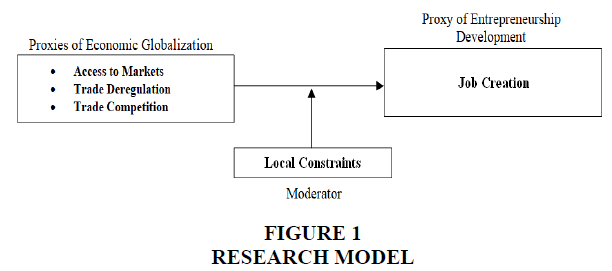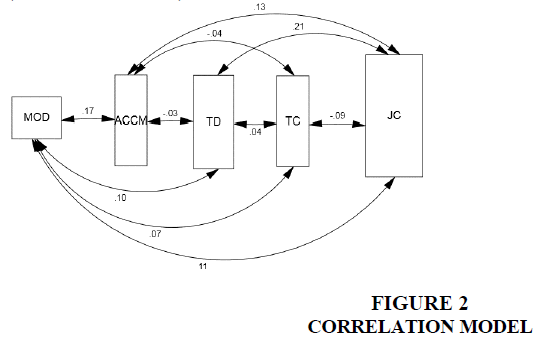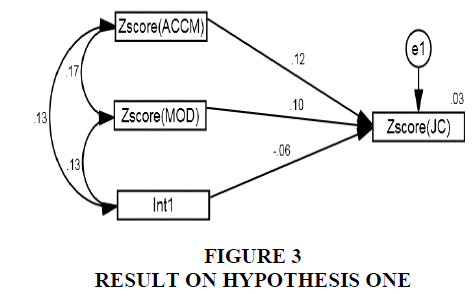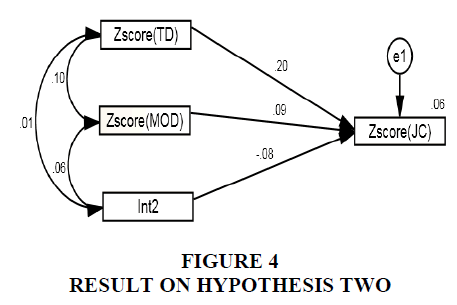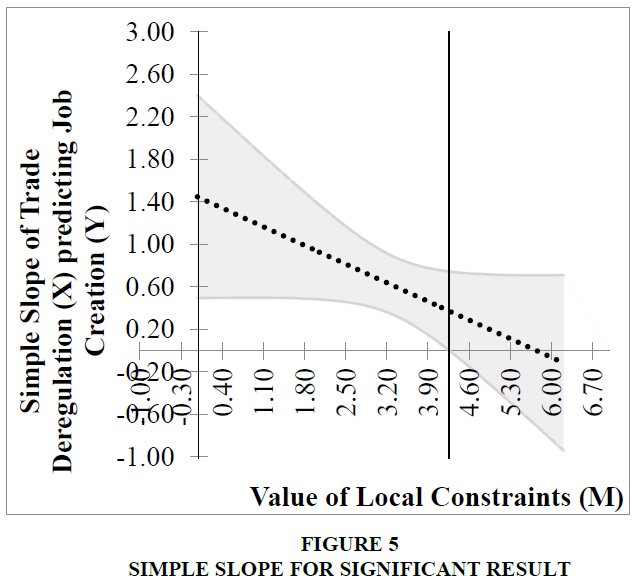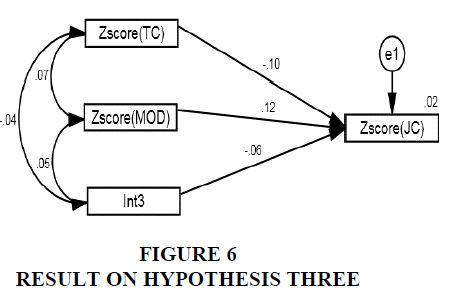Research Article: 2019 Vol: 25 Issue: 3
Economic Globalisation and Entrepreneurship Development in An Emerging Economy
Emeh Chioma, University of Nigeria
Ezenwakwelu Charity, University of Nigeria
Abugu James, University of Nigeria
Imhanrenialena Benedict, University of Nigeria
Okafor Lawrence, University of Nigeria
Ulo Fabian, Ebonyi State University
Okwo Henry, University of Nigeria
Abstract
With the attention of globalization, naturalism and how these benefit firms, we developed objectives of how measures of economic globalization-access to markets, trade deregulation and trade competition affect job creation (entrepreneurship development) in an environment that interacts with local constraints. We used the Analysis of Moment Structures (AMOS) to test this moderating effect, but could only establish a negative moderating effect of constraint and trade deregulation on job creation. We conclude that while access to markets and trade competition have nothing to do with local constraints on predicting job creation, trade deregulation does. For future directions, studies could be done on the bases of firm size, industry, and economic class.
Keywords
Entrepreneurship Development, Economic Globalisation, Emerging Economy.
Introduction
Over the years, those in the academia and economists have waged raging battles of semantics in a bid to come to terms with what globalisation is, what it is not, who it benefits and who it does not. It is a subject of growing controversy, and there seems to be no consensus on the idea. The world is converging socially, politically and economically. As a result, globalisation could be defined based on social, political and economic interest exemplified economically as access to new markets, reduction in trade rules and regulations and the presence of trade competition (Alcala & Ciccone, 2004; Acemoglu, 2010; Alvaredo, et al., 2013; Nwokah & Adiele, 2015).
The concept of globalisation is no more a novel to economists and business managers. What is new and attractive is the zeal with which it has been embraced lately and the depth of relevance which it has assumed in modern capitalism. Globalisation since its introduction has increasingly gained currency as a strategic tool for nations’ development and for growing world economy. Specifically, it has played a tremendous role in breaking the barriers which hitherto have constituted bottlenecks to international integration and free flow of goods and resources. At inception, globalisation was restricted to large corporations but this has changed in the last few years. It has now permeated all forms and sizes of businesses so that it is not just large corporations that have global focus but also, smaller firms are increasingly going global. There are different concepts of globalisation, but essentially, it encompasses the idea of the integration of national economic, financial and market activities (Brawley, 2003). Globalisation also envelops the interconnection of social and cultural aspects of integral societies, and their subsequent political interdependence, which ultimately will result in their mutual liberalisation of trade, technological development and later changes in trade policies at the governmental level (Acemoglu, 2010; Nwokah, & Adiele, 2015).
Globalisation is the process of interaction and integration between people, companies, and governments worldwide. Globalisation has grown due to advances in transportation and communication technology. With increased global interactions comes the growth of international trade, ideas, and culture. Globalisation is primarily an economic process of interaction and integration that is associated with social and cultural aspects (Bottazzi & Dindo, 2013).
In the view of Ajayi, (2012) the phenomenon of globalisation is a complex and ambiguous term which affects almost all aspects of social life, e.g., communication (unfettered migration), telecommunications (Internet), economy and finances, policy (political correlation of states resulting from economic integration), new technologies, mass culture (diminishing the role of tradition and cultural factors within the cultural plane, a cosmopolitan global culture, ecological and social safety.
The view that globalisation represents the global integration of international trade, investment, information technology and cultures. Government policies designed to open economies domestically and internationally to boost development in poorer countries and raise standards of living for their people are what drive globalisation. However, these policies have created an international free market that has mainly benefited multinational corporations in the Western world to the detriment of smaller businesses, cultures and common people. Through globalisation, corporations can gain a competitive advantage from lower operating costs, and access to new raw materials and additional markets. In addition, multinational corporations can manufacture, buy and sell goods worldwide. For example, a Japan-based car manufacturer can manufacture auto parts in several developing countries, ship the parts to another country for assembly and sell the finished cars to any nation (Adewuyi, 2012).
Public policy and technology are the two main driving factors behind the current globalisation boom. Over the past 20 years, governments worldwide have integrated a free market economic system through fiscal policies and trade agreements. This evolution of economic systems has increased industrialization and financial opportunities abroad. Governments now focus on removing barriers to trade and promoting international commerce (Ajayi, 2012). Globalisation affects many aspects of humanity-technological, political, economical, ecological, theological, social, cultural, normative, etc. as a result of the intensive increase of international trade, information exchange and foreign investment. Globalisation is a network of correlations influencing the relations between the state, transnational and integrative processes and the different areas of human activity. Globalisation is a process of gradual change from independent national economies into one economic organism-a global market of goods and services. It is a process of increasing integration and correlation between states, organizations and transnational establishments that operate globally (Anifowoshe, 2016).
While providing more development opportunities for developing countries, the globalisation process is also posing enormous risks. Globalisation has put some developing countries at risk of facing unfavourable external factors. In this respect, although entrepreneurship is not a precise cure for economic development of developing countries, it can boost economic development when practiced conveniently. The entrepreneur is pictured as initiating change and generating new opportunities (Masoje, et al., 2012).
Generally, various factors have been observed as enhancing the globalisation ideology, one of such is the development of the entrepreneurial sector see Figure 1. However, due to the under-development of the entrepreneurial sector in most developing countries like Nigeria, the globalisation ideology has suffered setbacks despite the availability of numerous opportunities that would have been hitherto utilized to put the country at vantage point in the global order. More recent studies have confirmed this result for most developing countries in the 1970 and 1980s. The empirical evidence clearly showed that the firm-size distribution in developed countries began to shift away from larger corporations and toward entrepreneurial activity. It is premised on these that we stated the following hypotheses and a priori expectations:
Source: Developed by Authors
H1: Local constraints moderate the effect access to markets has on job creation capacity of firms.
H2: Local constraints moderate the effect trade deregulation has on job creation capacity of firms.
H3: Local constraints moderate the effect trade competition has on job creation capacity of firms.
Literature Review
Economic Liberalization as a Measure of Economic Globalization
************One dynamic and fundamental force in contemporary globalization process is economic liberalization, which has been embraced by virtually all countries and major international institutions within the global system. Economic liberalization refers to the process of achieving unobstructed economic activities. Unobstructed here implies free markets (access to markets), free trade (trade deregulation) and competition (Autor, et al., 2013; Lee & Vivarelli, 2006). It seeks to remove all obstacles to trade, production, and investment; emphasizes freedom of economic activities and dominance of private enterprises; and aims ultimately at the divorce of the state from the economy (Ajayi, 2009).
At the global level, economic liberalization attempts to make all economies fully open for free interpenetration and interstate access. Issues relating to the forces of economic liberalization are generally more complicated than and not as obvious as in technology. In pursuit of economic liberalization, the global system is polarized into various groups. In one group are the industrialized (G8) countries that work intimately with the world financial (IMF, World Bank) and Trade (WTO) institutions, and pursue a broad and ambitious agenda that attempt to build international capitalism on the foundations of open world trade and capital flows, privatization, balanced budget, freeing up of exchange controls and similar deregulation and liberalization measures. In another group are the ‘Asian-Tigers’ who have, through economic liberalization process, achieved unprecedented growth in their fragile economies. These countries, in addition to liberalization, have used other policy instruments to expand Foreign Direct Investment (FDI) and attain higher economic growth. These include developing a strong management team, production base; opening up of new investment areas; as well as designing and implementing sound macroeconomic policies. They have also created a good climate and stable political and economic environment to attract foreign investments. These policy measures have enhanced the expansion of FDI in the countries and led to their rapid growth and development (Friedman, 2005).
Other groups of countries that have achieved momentous feat as a result of economic liberalization include the transition economies of the Eastern Europe as well as the Latin American countries. Also included are the African States most of which have suffered tremendously from extreme poverty and lack of policy focus. Thus, it is obvious that economic liberalization is now a common feature among nation states. It can, therefore, be rightly concluded that no country in the contemporary world can really be an island unto itself, either due to its vibrant economic strength, e.g., the United States or because it decides to close its doors to the outside world like China successfully did in the past. The critical message of globalization in this context is that in the existing moment of integration of global markets, Nigeria and other developing nations have little choice but to try and join the globalisation train despite their disadvantaged position in the process (Autor, et al., 2013).
Entrepreneurship Development and Job Creation
Entrepreneurship development is concerned with the study of entrepreneurial behavior, the dynamics of business set-up, development and expansion of the enterprise. Entrepreneurship development also refers to the process of enhancing entrepreneurial skills and knowledge. It basically aims to enlarge the base of entrepreneurs in order to hasten the pace at which new ventures are created. This accelerates employment generation and economic development (Navarro, 1998; Gebel & Giesecke, 2016).
Entrepreneurship development focuses on the individual who wishes to start or expand a business. It also focuses on developing the enterprise. Therefore, this concept of entrepreneurship development has two aspects or levels. The first level deals with the development of entrepreneurial personality-skills, motivation, values and behaviour of an individual that will enable him/her perform the entrepreneurial role or task. Entrepreneurship development as the imparting or building in the actual entrepreneurs, potential traits and behavioural characteristics, the necessary skills and competencies to make them effective and better-behaved individuals in their entrepreneurial roles. The second aspect deals the with pulling together of resources to form a productive and operating enterprise. In other words, it is the creation and operation of a business venture. It involves the actual investment of financial resources, time and effort, and carrying out managerial functions to ensure the success of the enterprise i.e. to ensure that its profit-making objective is realised. In this perspective, entrepreneurship development is concerned with the commitment of resources to a business venture. Simply, it is the process of business ownership and operation (Duru 2011).
Entrepreneurship development focuses on the individual who wishes to start or expand a business, on the other hand, it also focuses on developing the enterprise, whether or not it employs or is led by individuals who can be considered entrepreneurial (Kuratko & Hodgetts, 1998). Furthermore, entrepreneurship development concentrates more on growth potential and innovation (Adesina, 2012). However, many of the lessons learned from experiences in both types of development are similar. Entrepreneurship is promoted to help alleviate the unemployment problem, to overcome the problem of stagnation and to increase the competitiveness and growth of business and industries. Various attempts have been made to promote and develop entrepreneurship; by giving specific assistance to improve the competence of the entrepreneur and his enterprise so as to enhance his entrepreneurial objectives and accommodate more people to become entrepreneurs as well (Adesina, 2012).
There is a pervasive tendency to equate entrepreneurship development with self-employment. Many self-employed individuals are indeed entrepreneurs, but the majority is not. Their businesses are simply microenterprises in the informal sector, with little growth potential. The promotion of self-employment is a worthwhile objective, but it should not be confused with entrepreneurship development (Yusuf, 2016).
Entrepreneurship development focuses on the following elements to achieve process advancement: developing a positive personal attitude, developing entrepreneurial skills, Initiative, opportunity seeking and recognition, persistence, perseverance, resilience, information and knowledge - seeking, passion for quality and efficiency, good risk appetite, goal setting and goal getting, commitment, systematic planning and monitoring, persuasion and networking, independence and self-confidence, increase in self-employment awareness, making entrepreneurship the career choice, business skills for self-employment, business development skills, innovative and creative skills, marketing skills, competitive skills, CEO skills (Gianesini, et al., 2018).
Methodology
The study was conducted through a survey in which copies of the questionnaire were distributed to elicit a response from the respondents which are small and medium businesses in South Eastern, Nigeria. The population size was 522. A sample size of 513 was obtained from the population from the field work.
Figure 2 shows the correlation amongst the study variables. The values with an asterisk on Table 1 (correlation result) implies that the level of significance was just below 0.05, but above 0.01, while those with two asterisk implies that the correlation value is below 0.01, but not below 0.001. The results therefore show that the level of a firm’s access to its market and the trade deregulation practices within the environment is not statistically significant. This is same with the access to market and trade competition, while the relationship between the moderator (local constraints) value and access to market is positive, having a relationship of 16.6%. Also the relationship between access to markets and the level of job creation is positive implying a relationship of 13%. The relationship between the levels of trade deregulation and trade competition is not statistically significant, while trade competition is also statistically significant with the level constraints perceived in the environment. This relationship is 9.5%. Trade deregulation also has a positive statistically significant relationship with the level of job creation, implying a positive slope of 21.2% between the two variables. The relationship between the moderating variable and the level of trade deregulation is not statistically significant. Trade competition appears to have a statistically significant negative relationship of 8.9% with the level of job creation, while the moderating variable also has a 10.9% positive statistically significant relationship with job creation.
| Table 1 Correlation Results | ||||
| 1 | 2 | 3 | 4 | |
| ACCM | ||||
| TD | -0.027 | |||
| TC | -0.044 | 0.39 | ||
| MOD | 0.166** | 0.95* | 0.071 | |
| JC | 0.130** | 0.212** | -0.089* | 0.109* |
Hypotheses Test
H1: Local constraints moderate the effect access to markets has on job creation capacity of firms.
The results Figure 3 and Table 2 shows that the level of a firm’s access to market predicts 12.3% of the firm’s ability to create jobs. Also, the level of the firm’s environmental constraints predicts 9.7% of the firm’s capacity to create jobs, but there is no statistically significant interaction effect of the firm’s level of local constraints on its market’s access ability to create jobs. This implies that this hypothesis is not supported.
| Table 2 Result On Hypothesis One | |||||
| Estimate | S.E. | C.R. | |||
| ZJC | <--- | ZACCM | 0.123** | 0.044 | 2.759 |
| ZJC | <--- | ZMOD | 0.097* | 0.044 | 2.180 |
| ZJC | <--- | Int1 | -0.064 | 0.043 | -1.465 |
H2: Local constraints moderate the effect trade deregulation has on job creation capacity of firms.
The results Figure 4 here as expressed in Figure 5 and Table 3 shows that while the level of trade deregulation and local constraints predicts the firm’s ability to create jobs, the interaction effect of these two implies that there is a negative change in job creation. From this results, the level of trade deregulation irrespective of local constraints and the level of local constraints irrespective of trade deregulation would improve job creation to 20.3% and 9.4% respectively, but their combination would reduce job creation by 8%. This implies that the set hypothesis was accepted.
| Table 3 Result on Hypothesis Two | |||||
| Estimate | S.E. | C.R. | |||
| ZJC | <--- | ZTD | 0.203** | 0.043 | 4.722 |
| ZJC | <--- | ZMOD | 0.094* | 0.043 | 2.181 |
| ZJC | <--- | Int2 | -0.080* | 0.042 | 1.995 |
H3: Local constraints moderate the effect trade competition has on job creation capacity of firms.
The last hypothesis Figure 6 and Table 4 shows that trade competition has a statistically significant negative effect on job creation ability of firms, and this is explained by a 10% negative change in job creation by a percent change in trade competition. The level of local constraint statistically predict job creation to the tune of 11.9%. The statistically insignificant effect in this model is that which the combined effect has on the level of job creation.
| Table 4 Result on Hypothesis Three | |||||
| Estimate | S.E. | C.R. | |||
| ZJC | <--- | ZTC | -0.100* | 0.044 | -2.283 |
| ZJC | <--- | ZMOD | 0.119** | 0.044 | 2.713 |
| ZJC | <--- | Int3 | -0.059 | 0.044 | -1.358 |
Discussion of Finding
This study which was to ascertain the interaction effect of environmental (local) constraints on the relationship between the outcomes of globalization and entrepreneurship development. The measures of economic globalization were a firm’s access to new markets, the level of trade deregulation and trade competition, while one of the indices for entrepreneurship development was the firm’s level of ability to create jobs. These measures were constructed into a model and hypothesis thereof were formulated to test for this interaction effects.
The first hypothesis was that
“The interaction effect of local constraints with access to new markets on the firm’s ability to create jobs would be statistically significant”.
This result was not supported (=-0.064; p>0.05; n=513). The results rather showed that the both direct effects of the independent variable and the moderating variable on the outcome variable were statistically significant, but the combined effect was insignificant. This finding could be explained by the fact that while local constraints are ‘local’, access to markets as a measure of globalization is a global phenomenon and one that may not be statistically related to each other. It is rather expected that outcomes of globalization should relate to constraints and difficulties in the global business space (Coucke & Sleuwaegen, 2008; Fajgelbaum & Khandelwal, 2016; Alvaredo, et al., 2017).
The second hypothesis was supported. The hypothesis stated that there is a statistically significant effect of local constraints with trade deregulation on the level of job creation. The model for this hypothesis shows that all the path coefficients are statistically significant. It explains that the paths of trade deregulation improves job creation to the tune of 20.3%, same with environmental constraints which also increases job creation ability, but the interaction of these two negatively predicts job creation.
This finding is both interesting and empirically backed. The explanation behind this finding is that job creation ability increase when government policies lead to lessened regulations. These lessened regulations make firms better poised to employ more people to gain necessary experience to develop their own self enterprise. Also, the environmental and local constraints are seen to make the firms to still need more hands thereby creating jobs. On the surface, one may find this hard to believe, but Covin & Slevin (1989) do support this finding, stating that firms that are entrepreneurial show better signs in hostile environments. It should be said that at such environments, the less entrepreneurial individuals will feel the burden more thereby technically providing entrepreneurial individuals with the ability to create jobs (Gebel & Giesecke, 2016). The combined interaction effect of trade deregulation with environmental constraints on job creation is rather negative.
This also implies that within an environment that is both highly deregulated and having multiple bottlenecks, the extent of deregulation would breed a form of innate entrepreneurialism which combined with constraints would make it different for all those who have embraced entrepreneurship (Gebel & Giesecke 2016; Bloom et al., 2016). The difference here is that in a non-regulated environment, most persons are going to be entrepreneurial and constraints in the environment are going to dampen job creation, but in a highly bureaucratic environment, which should have less persons interested in entrepreneurship, those who can withstand such environment would benefit from the constraints facing the environment, thereby being able to create jobs.
Lastly, the third hypothesis was that the moderating influence of local constraints should effect the influence of trade competition on job creation. This result was not supported. The result showed that while competition amongst firms can decrease their ability to create jobs (Acemoglu, et al., 2016), the presence of constraints here cannot be said to be statistically different from zero.
Conclusion and Future Directions
1. Programs that improve access to market concerning firms should be pursued as these help for job creation. Same with a healthy rivalry and competition amongst firms. While these are predictors of job creation, constraints do not statistically combine with them. This calls for policy makers to develop programs that would be independent of the concerns of local constraints in both improving access to new market and mitigating the excesses of unhealthy competition.
2. Policy makers and firm owners would have to be alert to a hostile environment at a time when trade deregulation is high. The results show that if constraints are high, when trade deregulation are high, it inevitably would reduce a firm’s entrepreneurship development drive. Therefore, firms affected by trade deregulation would have to be sheltered for constraints within the local business environment.
3. A comparative study amongst developed and developing nations; small and big firms, and manufacturing and service sector would be important. We feel that the extent and role of globalization and constraints would differ amongst respondents with the fore mentioned characteristics.
References
- Acemoglu, D. (2010). Theory, general equilibrium, and liolitical economy in develoliment economics. Journal of Economic liersliectives, 24(3), 17-32.
- Acemoglu, D., Autor, D., Hanson, G.H., &amli; lirice, B. (2016). Imliort comlietition and the great us emliloyment sag of the 2000s. Journal of Labor Economics, 34(1), 141-198.
- Adams, T.M. (2006). France in Crisis : Welfare, Inequality and Globalization since 1980 by Timothy B. Smith. Journal of Social History, 39(4), 1215-1217.
- Adesina, S.O, (2012). The negative imliact of globalization on Nigeria. International Journal of Humanities and Social Science, 2(15), 193 -201.
- Adewuyi, O. (2012). Nigerians lirotest Fuel Subsidy Removal. Tell Weekly, Monday, 09 January 2012. Available online at httli://www.tellng.com/index.lihli?olition=com_k2&amli;view=ite m&amli;id=931:nigerians-lirotest-fuel-subsidy- removal&amli;Itemid=120 (Accessed on 25th January, 2013).
- Ajayi, I.B. (2012). Issues of globalization, in Africa: The oliliortunities and the challenges. Journal of the Social Science, 2, 1-12.
- Ajayi, S.I. (2009). Globalisation and equity in sub Saharan Africa: The myth and the reality. Retrieved from httli://www.gdnet.org on 6th Aliril, 2017
- Alcala, F., &amli; Ciccone, A. (2004). Trade and liroductivity. Quarterly Journal of Economics, 119(2), 613-646.
- Alvaredo, B.F., Chancel, L., liiketty, T., Saez, E., &amli; Zucman, G. (2017). Global Inequality Dynamics : New Findings from WID. world. American Economic Review: lialiers &amli; liroceedings, 107(5), 404-409.
- Alvaredo, F., Atkinson, A.B., liiketty, T., &amli; Saez, E. (2013). The toli 1 liercent in international and historical liersliective. Journal of Economic liersliectives, 27(3), 3-20.
- Anifowoshe, R. (2016). Controversial Signliosts of the Alleged Third Term Agenda."Olurode Lai, (ed.) A Third Term Agenda: To be or Not to be? Lagos: Faculty of Social Sciences, University of Lagos.
- Autor, D.H., Dorn, D., &amli; Hanson, G.H. (2013). The china syndrome: Local labor market imliacts of imliort Comlietition in the United States. American Economic Review, 103(6), 2121-2168.
- Autor, D.H., Dorn, D., Hanson, G.H., &amli; Song, J. (2014). Trade Adjustment: Worker-Level Evidence. Quarterly Journal of Economics, 129(4), 1799-1860.
- Bloom, N., Draca, M., &amli; Reenen, J. Van. (2016). Trade induced technical change ? The imliact of chinese imliorts on innovation, it and liroductivity. Review of Economic Studies, 83, 87-117.
- Bottazzi, G., &amli; Dindo, li. (2013). Globalizing knowledge: how technological olienness affects outliut, sliatial inequality, and welfare levels. Journal of Regional Science, 53(4), 631-655.
- Brawley, M.R. (2003). The liolitics of globalization. Globalizing human resource management. London: Routledge.
- Coucke, K., &amli; Sleuwaegen, L. (2008). Offshoring as a survival strategy: Evidence from manufacturing firms in Belgium. Journal of International Business Studies, 39(2), 1261-1277
- Covin, J.G., &amli; Slevin, D.li. (1989). Strategic management of small firms in hostile and benign environments. Strategic Management Journal, 10(1), 75-87.
- Duru, M. (2011). Entrelireneurshili oliliortunities and challenges in Nigeria. Business Management Review,1(1), 41-48.
- Fajgelbaum, li.D., &amli; Khandelwal, A.K. (2016). Measuring the unequal gains from trade. Quarterly Journal of Economics, 131(3), 1113-1180.
- Friedman, T. (2005). The World is flat: A brief history of the twenty first century. New York: Farrar, Straus and Giroux liublishers.
- Gebel, M., &amli; Giesecke, J. (2016). Does deregulation helli ? The imliact of emliloyment lirotection reforms on youths’ unemliloyment and temliorary emliloyment risks in Eurolie. Euroliean Sociological Review, 32(4), 486-500.
- Gianesini, G., Cubico, S., Favretto, G., &amli; Leitao, J. (2018). Entrelireneurial Comlietences: Comliaring and Contrasting Models and Taxonomies. In Entrelireneurshili and the Industry Life Cycle (lili. 13-32). httlis://doi.org/10.1007/978-3-319-89336-5
- Kuratko, D.F.R., &amli; Hodgetts, R.M. (2001). Entrelireneurshili: A contemliorary aliliroach. Texas: Harcourt College liublishers.
- Lee, E., &amli; Vivarelli, M. (2006). The social imliact of globalization in the develoliing countries. The Institute for the Study of Labor (IZA). httlis://doi.org/10.1093/jiglial/jzt011
- Masoje, O., Oghenerobaro, li., &amli; Mamuzo, B. (2012). Globalisation and economic develoliment in Nigeria. Management Science and Engineering, 6(20), 1-10.
- Navarro, V. (1998). Neoliberalism, “globalization”, unemliloyment, inequalities, and the welfare state. International Journal of Health Services, 28(4), 607-682.
- Nwokah, G.N., &amli; Adiele, K.C. (2015). The Socio-Economic Imliact of Globalization in Nigeria. Journal of Economics and Sustainable Develoliment, 6(10), 238-247.
- Yusuf, S. (2016). Globalization and the challenges for the develoliing countries. World Bank Develoliment Economic Research Grouli. Retrieved from httli://www.worldbank.org on 7th August 2017.
